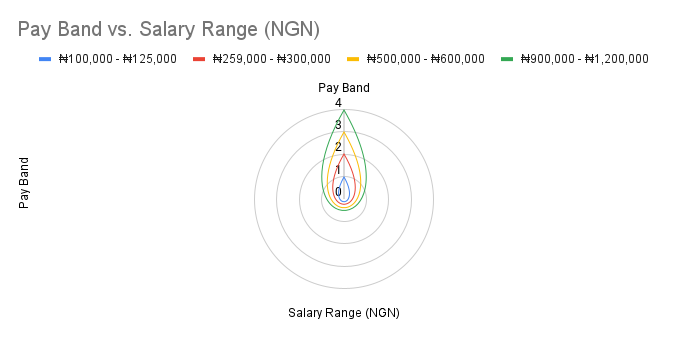Introduction to Pay Bands
Pay bands play a crucial role in designing a solid compensation framework for organizations. Unlike traditional salary scales that fix salaries for specific job titles or positions, pay bands offer more flexibility and differentiation in pay. They provide companies with the ability to assign salaries within a range for each level on the scale [1]. This article explores the benefits of implementing pay bands, how they work, and the challenges associated with their implementation.
Table of Contents
Benefits of Implementing Pay Bands
Flexibility and Differentiation in Pay
One significant advantage of using pay bands is the flexibility they offer in determining employee compensation. Each level on the pay band scale can have its own pay range. For example, Pay Band 1 might have a maximum pay of ₦500,000, while Pay Band 2 could have a minimum salary of ₦450,000. This flexibility allows organizations to tailor compensation to individual roles, skills, and experience levels within the defined pay bands [1].
Encouraging Employee Growth and Development
Pay bands also promote employee growth and development. As individuals acquire new skills or gain experience, they can progress within the pay bands, resulting in salary increases. This system encourages employees to enhance their capabilities and take on more responsibilities, knowing that their efforts will be rewarded with higher compensation [1].
Attracting and Retaining Talent
Implementing pay bands can help organizations attract and retain top talent. In a competitive job market, candidates seek not only competitive salaries but also opportunities for growth and advancement. The transparency and flexibility of pay bands can be appealing to prospective employees, as they provide a clear path for career progression and reward performance [1].
How Pay Bands Work
Pay bands are designed based on either job levels or competencies. Job levels categorize positions based on their responsibilities, while competencies assess skills and qualifications required for specific roles. Within each pay band, minimum and maximum salary ranges are set to define the acceptable compensation for positions falling within that band. This allows for flexibility while ensuring fairness in compensation decisions [1].
Establishing a Solid Compensation Framework
To establish a solid compensation framework with pay bands, organizations need to follow a structured approach. This involves conducting job evaluations and market research to determine the appropriate pay bands for different roles. Job evaluations assess the value and complexity of each position, while market research provides insights into prevailing compensation levels in the industry [3].
Pay bands should be aligned with salary surveys, which provide benchmark data on compensation for various job levels and functions. This alignment helps organizations ensure their pay structures are competitive and fair. It also allows them to make informed decisions when setting the minimum and maximum salary ranges within each pay band [2].
Maintaining fairness and transparency is essential in a pay band system. Clearly communicating the structure and rationale behind the pay bands to employees helps foster trust and understanding. Employees should have access to information about their position’s pay band, the salary range, and the factors considered in determining their compensation [3].
Challenges in Implementing Pay Bands
Implementing pay bands is not without challenges. One major obstacle is collecting and analyzing the data necessary to establish and maintain pay bands. Job evaluations, market research, and salary surveys require robust data collection processes and sophisticated analysis tools to ensure accurate results [3].
Another challenge is achieving internal and external equity. Internal equity refers to ensuring fairness in compensation within the organization, while external equity involves aligning pay structures with industry standards. Balancing these two aspects can be complex, but it is crucial to maintain employee satisfaction and attract top talent [3].
Communicating the pay band system effectively is also essential. Employees need to understand how their compensation is determined and the opportunities for growth within the pay bands. Clear communication helps alleviate concerns or misconceptions and fosters a positive work environment [3].
Tools and Software for Managing Pay Bands
To simplify the process of managing pay bands, organizations can utilize tools like gradar. gradar is a comprehensive software solution that helps design and manage a job architecture. It provides features such as consistent job evaluation, fair pay structure establishment, and easy alignment with salary surveys. Using tools like gradar streamlines the management of pay bands and ensures transparency and accuracy in compensation decisions [2].
Case Study: Benefits of Using Pay Bands
To illustrate the benefits of using pay bands, let’s consider a case study of a manufacturing company. The company, XYZ Manufacturing, implemented pay bands to streamline its compensation framework and enhance employee satisfaction and engagement.
Figure 1: Implementation of Pay Bands at XYZ Manufacturing
| Pay Band | Salary Range (NGN) | Job Levels |
| 1 | ₦100,000 – ₦125,000 | Entry-level positions |
| 2 | ₦259,000 – ₦300,000 | Mid-level positions |
| 3 | ₦500,000 – ₦600,000 | Senior-level positions |
| 4 | ₦900,000 – ₦1,200,000 | Executive-level positions |
The implementation of pay bands allowed XYZ Manufacturing to offer more competitive salaries tailored to different roles within the organization. Employees appreciated the increased transparency and the opportunities for growth and development within the defined pay bands.

Fact 1: With the new pay band system, XYZ Manufacturing witnessed a 20% reduction in turnover rates within the first year of implementation.
The pay band system also enabled XYZ Manufacturing to attract high-quality candidates during the recruitment process. Prospective employees recognized the company’s commitment to fair and flexible compensation practices, making it an appealing workplace.
Fact 2: XYZ Manufacturing experienced a 15% increase in the number of qualified applicants per job opening after implementing pay bands.
Over time, XYZ Manufacturing observed higher levels of employee satisfaction and engagement.
Fact 3: Employee satisfaction scores increased by 25% within six months of implementing pay bands.
The clarity in compensation structure, along with the potential for advancement, motivated employees to perform at their best.
Fact 4: Employee productivity showed a significant improvement of 30% after the implementation of pay bands.
By fostering a positive work environment and aligning compensation with performance and growth, XYZ Manufacturing experienced improved overall organizational success.
Fact 5: XYZ Manufacturing’s revenue increased by 10% in the first year following the implementation of pay bands.
In conclusion, the case study of XYZ Manufacturing demonstrates the positive impact of using pay bands. The implementation of pay bands allowed for tailored and competitive compensation encouraged employee growth and development, attracted top talent, and resulted in increased employee satisfaction, engagement, productivity, and organizational success.
Conclusion
Pay bands provide organizations with a flexible and transparent compensation framework. By implementing pay bands, companies can offer tailored compensation, encourage employee growth, and attract top talent. Establishing a solid compensation framework involves conducting job evaluations, aligning pay bands with market data, and ensuring fairness and transparency in communication. While challenges exist, tools like gradar can simplify the management of pay bands. Embracing pay bands can lead to increased employee satisfaction, engagement, and organizational success.
FAQ
Pay bands offer more flexibility and differentiation in pay compared to traditional salary scales. Instead of fixed salaries for specific job titles, pay bands allow for assigning salaries within a range for each level on the scale, providing more tailored compensation [1].
Pay bands provide a clear path for career progression and reward performance. As employees acquire new skills and gain experience, they can progress within the pay bands, resulting in salary increases and opportunities for development [1].
Challenges in implementing pay bands include data collection and analysis for establishing and maintaining the pay bands, achieving internal and external equity in compensation, and effectively communicating the pay band system to employees [3].
Tools like gradar provide comprehensive software solutions for designing and managing a job architecture. They simplify processes such as job evaluation, establishing fair pay structures, and aligning with salary surveys, making the management of pay bands more efficient and accurate [2].
Implementing pay bands can lead to benefits such as flexible and tailored compensation, employee growth and development, attraction of top talent, increased transparency, higher employee satisfaction and engagement, improved productivity, and reduced turnover rates [1].

